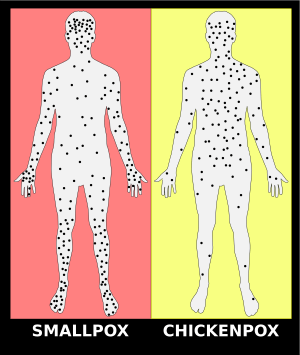Smallpox facts for kids

Smallpox was a very serious illness caused by a virus called Variola major. It was a highly contagious disease, meaning it spread easily from person to person. Smallpox was the first infectious disease that was completely wiped out from the world. This was thanks to a special shot called a vaccination.
Today, only two official samples of the smallpox virus exist. They are kept in very secure government labs in Russia and the United States. Even though the disease is gone, scientists worry that some samples might be elsewhere. Because smallpox could spread quickly and cause many deaths, there are plans ready in case of an outbreak. The vaccine can prevent the disease. It can also make a case less severe if someone gets sick.
Contents
History of Smallpox
Scientists believe smallpox first appeared in Africa. It might have come from a rodent living near the Nile River. From Africa, it then spread to China and India thousands of years ago. The first recorded outbreak of smallpox happened around 1350 B.C. during a war between Egypt and the Hittites.
About 2,000 years later, smallpox reached Europe. It caused many problems there from the 5th century until the 19th century. From Europe, the disease then spread to major cities worldwide. This included the American colonies in the 17th and 18th centuries.
Smallpox greatly affected how Western civilization grew. From the 10th to the 18th century, smallpox caused over 400,000 deaths each year. Experts believe the total number of deaths from smallpox could be between 300 and 500 million people.
How Vaccination Ended Smallpox
People noticed that those who survived smallpox never got it again. This led to a practice called Variolation. Variolation involved giving a healthy person a small amount of infected material. The hope was that they would get a milder form of the disease. After recovering, they would then be immune.
Over many centuries, doctors made variolation safer and more effective. A study in Boston showed its success. Out of 12,000 people who got smallpox naturally, 14% died. But among those who had variolation, only 2% died if they later caught the disease. These numbers made many more people choose to get variolation.
After hundreds of years of variolation, a new and better method was discovered. This new method would eventually lead to the end of smallpox.
Edward Jenner's Discovery
The story of modern vaccination began with a young boy named Edward Jenner. He was one of thousands of boys who received variolation. Edward grew up to be a successful scientist. He developed new ways of thinking and scientific methods.
His most important work came from his interest in cowpox. Cowpox is a milder virus similar to smallpox. Edward heard rumors that dairy maids, who often got cowpox, seemed to be immune to smallpox too. He studied a dairy maid with fresh cowpox sores on her hand. He saw that she was indeed immune to smallpox.
After much thought, Edward decided to try an experiment. He took material from a cowpox sore and put it into a cut on a boy. The boy got a mild case of cowpox. A few weeks later, Edward put fresh smallpox material into a cut on the same boy. The boy did not get smallpox. Edward Jenner realized that the cowpox had given the boy full immunity. This amazing discovery paved the way for smallpox to be completely removed from the world.
What Does Smallpox Mean?
The name "Smallpox" comes from the small, raised bumps that formed on the skin of people who had the disease.
Images for kids
-
Parts of a modern smallpox vaccination kit. This includes the liquid, a bottle of vaccine, and a special needle.
-
An 1802 cartoon by James Gillray about Edward Jenner's vaccination. It shows cows coming out of patients who received the cowpox vaccine.
-
A statue of Sopona, the Yoruba god believed to cause smallpox.
-
Getting vaccinated during the Smallpox Eradication Program in Niger, 1969.
See also
 In Spanish: Viruela para niños
In Spanish: Viruela para niños








